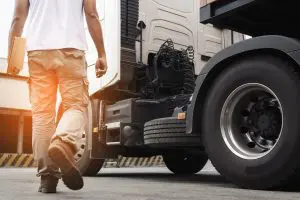When a truck crashes, it’s not just the driver who might be responsible. The trucking company they work for could also be liable for what happened. This matters if you’ve been injured in a truck accident and are facing medical bills, lost wages, or other expenses.
Trucking companies must follow strict safety regulations set by federal and state governments. These rules are designed to protect everyone who shares the road. When companies violate these safety standards, they can be held legally accountable if someone is hurt in an accident involving one of their trucks.
This means that if you’re injured in a truck accident, you may be able to seek compensation from both the driver and the trucking company. Understanding how trucking company liability works is essential for getting the full compensation you deserve.
At Munley Law, we have spent decades investigating trucking accidents and building strong cases against companies that disregard these important safety rules. If you or a loved one has been injured in a truck accident, contact our experienced trucking accident team today for a free consultation to learn how we can help protect your rights and pursue the compensation you deserve.
Trucking Company Liability Requirements
Trucking companies operate under extensive documentation requirements by the Federal Motor Carrier Safety Administration (FMCSA) that create a paper trail of their safety practices. They must maintain comprehensive driver files that include training records, qualifications,  medical exams, and driving history. Vehicle maintenance documentation requires detailed records of all repairs, inspections, and safety checks performed on the fleet.
medical exams, and driving history. Vehicle maintenance documentation requires detailed records of all repairs, inspections, and safety checks performed on the fleet.
Companies also track cargo information, including what’s being transported, how it’s secured, and its destinations. Hours of service monitoring ensures drivers get proper rest, while safety program documentation shows how companies monitor and enforce compliance across their operations.
Federal law requires substantial insurance coverage based on cargo type. General freight carriers need $750,000 minimum coverage, while hazardous materials transporters require higher amounts. Companies handling specialized cargo must carry additional coverage to protect against unique risks.
Safety protocols cover every aspect of trucking operations. Companies establish regular vehicle inspection schedules and driver training programs. They develop emergency response procedures so drivers and dispatchers know how to handle dangerous road situations. Maintenance standards ensure that trucks remain roadworthy, while compliance monitoring systems track safety performance and address violations before they lead to accidents.
Key Federal and State Rules
Driver Qualifications and Training
Commercial truck drivers must meet strict qualification standards:
- Valid Commercial Driver’s License with proper endorsements for their cargo type
- Regular medical exams to ensure physical fitness for operating large vehicles safely
- Clean driving records meeting federal safety standards
- Drug and alcohol testing, including pre-employment screening, random testing, and post-accident analysis
New drivers must complete Entry Level Driver Training programs that combine classroom instruction on regulations and safety with behind-the-wheel training from certified instructors. Skills testing and certification verify competency, while ongoing education requirements keep drivers current on changing regulations and safety practices.
Hours of Service and Fatigue Prevention
Federal regulations limit commercial drivers to prevent dangerous fatigue that impairs driving ability, similar to intoxication:
- Maximum 11 hours driving within a 14-hour workday
- 10 consecutive hours off duty before starting a new shift
- 34-hour restart period for weekly hour limits
- Mandatory breaks during long drives
Despite these clear rules, violations remain common. Companies sometimes pressure drivers to exceed hour limits to meet unrealistic delivery schedules. Some operations encourage falsifying logbook entries to hide violations, while others manipulate Electronic Logging Device records through technical means or require off-the-books driving that doesn’t appear in official logs.
Vehicle Safety and Maintenance Standards
 Proper vehicle maintenance directly impacts highway safety and accident prevention. Companies must conduct regular inspections according to federal schedules and address any discovered defects immediately. Detailed maintenance records document all repair work, while official logs track every maintenance activity performed on the fleet.
Proper vehicle maintenance directly impacts highway safety and accident prevention. Companies must conduct regular inspections according to federal schedules and address any discovered defects immediately. Detailed maintenance records document all repair work, while official logs track every maintenance activity performed on the fleet.
Modern trucks incorporate sophisticated diagnostic systems that monitor vehicle condition in real-time. These systems record maintenance needs and alert operators when components require attention, helping prevent breakdowns and accidents. They capture detailed performance data and document mechanical failures, creating a digital trail that reveals whether known problems were ignored. Safety system malfunctions are also recorded, showing when critical features like anti-lock brakes or stability control systems aren’t functioning properly.
Cargo Loading and Weight Regulations
Federal regulations set an 80,000-pound gross vehicle weight limit for most commercial trucks. Bridge formula calculations determine proper axle weight distribution, while special permits are required for overweight loads that exceed standard limits.
Loading requirements vary by cargo type. General freight requires proper tie-down methods and equipment, even load distribution, and secure attachment points. Hazardous materials demand enhanced safety protocols, special licensing and training, additional documentation, and emergency response planning.
Improper loading creates multiple dangerous scenarios. Jackknifing occurs when trailers swing around during turns or braking, often from improper weight distribution or overloaded braking systems. Rollovers become likely on curves when cargo isn’t properly secured or when the truck’s center of gravity is too high. Cargo shifts during transport can suddenly change vehicle balance and handling, making control difficult or impossible. Brake system failures often result from overweight loads that exceed the truck’s designed stopping capacity.
How Trucking Company Liability Is Established
Trucking company liability can arise through two primary legal paths:
- Direct liability occurs when a company’s actions or failures directly cause accidents through poor maintenance practices, inadequate driver training, unrealistic scheduling demands, or failure to enforce safety policies.
- Vicarious liability holds companies responsible for their drivers’ actions while operating company vehicles, working within their job duties, or following company policies and procedures.
Commercial carrier liability extends beyond simple employment relationships. Company negligence takes many forms that establish trucking company liability. Hiring and training problems include bringing on unqualified drivers, conducting insufficient background checks, providing inadequate training programs, or ignoring driver safety violations. Maintenance issues involve delaying necessary repairs, using substandard parts, skipping required inspections, or ignoring mechanical warnings. Operational failures include pressuring drivers to exceed legal limits, creating impossible delivery schedules, encouraging logbook falsification, or maintaining inadequate safety policies.
Proving Trucking Company Negligence and Liability
Establishing trucking company liability requires comprehensive evidence gathering from multiple sources—including electronic digital evidence, company internal records, physical evidence from the crash scene, and witness testimony—along with expert analysis.
Electronic and Digital Evidence
Electronic Logging Devices provide comprehensive records that reveal hours-of-service violations, showing when drivers operated beyond legal limits or skipped required rest periods. GPS tracking data reveals detailed information about speed violations, route deviations, and other operational infractions that may have contributed to accidents.
The truck’s Electronic Control Module acts as a “black box” recording vital operational data, including speed and acceleration patterns, braking events and intensity, hours of service information, and engine performance metrics. Onboard cameras capture driver behavior and road conditions leading up to accidents, providing visual evidence of unsafe driving or dangerous conditions.
This technological evidence creates an objective record that’s difficult for trucking companies to dispute, making it essential to preserve this data immediately after accidents occur.
Company Internal Records
Trucking companies maintain extensive internal documentation that sheds light on accident circumstances and reveals patterns of unsafe practices. Driver qualification files and training records reveal whether companies properly vet and train their drivers or cut corners that contribute to accidents. Vehicle maintenance logs and inspection reports reveal the true condition of trucks and whether companies addressed known problems promptly.
Delivery schedules and route planning documents can demonstrate whether companies pressured drivers to meet unrealistic deadlines that encouraged speeding or hours-of-service violations. Internal communication logs and dispatch records often contain evidence of company policies that prioritized profits over safety.
Physical and Witness Evidence
Accident scene evidence provides critical reconstruction information. Skid marks and tire impressions show braking patterns, vehicle paths, and speeds leading up to impact. Vehicle damage patterns and impact points reveal the sequence of events and forces involved in collisions. Debris placement and scatter patterns help experts determine vehicle positions and movements during crashes.
Witness accounts offer essential perspectives on events leading to accidents, but memories fade quickly, making prompt interviews vital. Surveillance footage from nearby businesses or traffic cameras might capture accidents, but could be deleted or recorded over if not secured immediately.
Critical Evidence Preservation Timeline
ACT IMMEDIATELY – Evidence disappears quickly after truck accidents
| Evidence Type | Preservation Window | Why It’s Critical |
|---|---|---|
| Electronic Control Module (ECM) Data | 30 days or less | Speed, braking patterns, and hours of service data can be overwritten automatically |
| Physical Evidence | Days to weeks | Skid marks, debris patterns, vehicle damage – weather can destroy quickly |
| Surveillance Footage | 30-90 days | Traffic cameras, business security systems showing the accident sequence |
| Driver Logs | 6 months | Hours of service compliance records, required by federal regulations |
| Maintenance Records | 1-3 years | Vehicle condition, safety inspections, and repair history documentation |
The difference between winning and losing a truck accident case often comes down to how quickly you act to preserve evidence.
Multiple Party Liability in Trucking Cases
Trucking company liability cases often involve several potentially responsible parties beyond just the driver and the primary trucking company. Freight brokers may share liability for inadequately screening carriers they hire. Equipment manufacturers can face product liability for defective parts or systems that contribute to accidents. Maintenance providers face potential liability for improper repairs or inadequate inspections.
Shipping companies may be held responsible for improper loading or cargo securement that leads to accidents. Even government entities can face premises liability when dangerous road conditions or poor maintenance contribute to crashes. Understanding all potential sources of commercial vehicle liability is essential for maximizing compensation in trucking accident cases.
Critical Deadlines and Time Limits for Filing Truck Accident Claims
State statutes of limitations set strict deadlines for filing truck accident claims. Most states allow 2-3 years from the date of the accident, although government claims often have shorter timeframes. The discovery rule may extend deadlines in certain circumstances, while wrongful death cases may have different time limits than personal injury claims.
Evidence preservation requires immediate action. Physical evidence at accident scenes can disappear within days or weeks due to weather and cleanup efforts. ECM data may be overwritten within 30 days or less. Surveillance footage is typically deleted or overwritten within 30-90 days. Driver logs must be preserved within 6 months under federal regulations, while maintenance records are kept for 1-3 years, depending on the specific documentation type.
State and Federal Regulatory Differences
While federal regulations provide the foundation for trucking safety, states may impose additional requirements. Statute of limitations periods vary by state, as do specific safety requirements beyond federal minimums. Insurance requirements may exceed federal standards in some states. Licensing endorsements can differ, and penalties for violations may be enhanced at the state level.
Recent regulatory changes continue evolving trucking safety requirements. Mandatory Electronic Logging Device compliance became fully implemented in 2019. Enhanced drug and alcohol clearinghouse systems began in 2020. Updated Entry Level Driver Training requirements took effect in 2022. Speed limiter requirements remain under ongoing discussion at the federal level.
Safety initiatives include increased Federal Motor Carrier Safety Administration enforcement actions, enhanced carrier safety ratings, improved crash causation studies, and technology-based monitoring systems that provide better oversight of trucking operations.
Why You Need Experienced Legal Representation for Trucking Company Liability Cases
 Trucking accident cases involve multiple areas of law and regulation that require specialized knowledge. Success depends on understanding federal and state trucking regulations, preserving critical electronic evidence before it’s lost, investigating all potentially liable parties, calculating accurate compensation for long-term impacts, and dealing with aggressive insurance company tactics designed to minimize payouts.
Trucking accident cases involve multiple areas of law and regulation that require specialized knowledge. Success depends on understanding federal and state trucking regulations, preserving critical electronic evidence before it’s lost, investigating all potentially liable parties, calculating accurate compensation for long-term impacts, and dealing with aggressive insurance company tactics designed to minimize payouts.
The trucking industry and its insurers begin protecting their interests immediately after accidents occur. They dispatch teams to accident scenes, interview witnesses, and start building defenses before victims even understand the full extent of their injuries. This makes it essential for accident victims to get equally experienced representation to ensure their rights are protected and they receive fair compensation in trucking company liability cases.
Time is critical in establishing trucking company liability because evidence can disappear, witnesses’ memories can fade, and legal deadlines approach quickly. The sooner victims get professional help, the better their chances of preserving critical evidence and building a strong case for maximum compensation against all liable parties.
Munley Law’s Trucking Accident Expertise
 Munley Law has dedicated decades to investigating trucking accidents and understanding the intricate web of federal and state regulations that govern the industry. We are one of the few law firms in the U.S. with three attorneys board-certified in truck accident law by the National Board of Trial Advocacy, and the only firm to have had two lawyers simultaneously leading the American Association for Justice’s Trucking Litigation Group. Our team has secured billions in settlements and verdicts specifically for truck accident victims.
Munley Law has dedicated decades to investigating trucking accidents and understanding the intricate web of federal and state regulations that govern the industry. We are one of the few law firms in the U.S. with three attorneys board-certified in truck accident law by the National Board of Trial Advocacy, and the only firm to have had two lawyers simultaneously leading the American Association for Justice’s Trucking Litigation Group. Our team has secured billions in settlements and verdicts specifically for truck accident victims.
Our extensive experience includes preserving critical electronic evidence, analyzing complex ECM data, and building compelling cases against companies that prioritize profits over safety. We maintain relationships with accident reconstruction experts, medical professionals, and industry specialists who help strengthen our clients’ cases. When trucking companies and their insurers mobilize their resources immediately after accidents, you need equally experienced advocates who understand how these cases are won. Our track record demonstrates our commitment to holding negligent companies accountable and securing maximum compensation for injured victims and their families.









